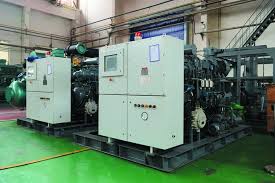Batching Chiller Installation At Construction Site
Sep 19, 2025
Chemical plants operate under demanding conditions, where maintaining precise process temperatures is critical for efficiency, safety, and product quality. Many chemical reactions are highly sensitive to fluctuations in temperature, and improper cooling can lead to production losses or even hazardous situations. One solution increasingly adopted by chemical facilities is the use of glycol chillers. The installation of glycol chillers in a chemical plant provides reliable, consistent cooling that
Glycol Chillers Installation in a Chemical Plant
Chemical plants operate under demanding conditions, where maintaining precise process temperatures is critical for efficiency, safety, and product quality. Many chemical reactions are highly sensitive to fluctuations in temperature, and improper cooling can lead to production losses or even hazardous situations. One solution increasingly adopted by chemical facilities is the use of glycol chillers. The installation of glycol chillers in a chemical plant provides reliable, consistent cooling that supports smooth operations.
Why Glycol Chillers?
Glycol chillers use a mixture of water and glycol (ethylene or propylene glycol) as a coolant, which circulates through heat exchangers to maintain the required temperature. Glycol is particularly effective in industrial cooling because it prevents freezing, resists corrosion, and ensures steady heat transfer even under extreme conditions.
For chemical plants, glycol chillers are ideal because they can maintain both low and stable temperatures, crucial for processes such as solvent recovery, distillation, reactor cooling, and storage. Unlike conventional water chillers, glycol systems perform reliably even in sub-zero conditions, making them suitable for facilities operating in varied climates.
Installation Process
The installation of glycol chillers in a chemical plant begins with a comprehensive assessment of the cooling load and process requirements. Engineers calculate the exact temperature ranges needed for different units such as reactors, condensers, and storage tanks. Based on this, they design a system that includes the chiller, pumps, piping, and distribution network.
During installation, attention is given to the glycol concentration ratio. A proper balance ensures freeze protection while maximizing efficiency. Typically, a 30–40% glycol concentration is sufficient, but exact levels are adjusted depending on the plant’s operating environment.
Piping and insulation are also critical. Since glycol can degrade if exposed to excessive heat, the piping system is insulated to maintain fluid stability. Additionally, advanced controls are integrated to allow operators to adjust temperature setpoints and monitor system performance in real time.
Benefits of Glycol Chillers in Chemical Plants
Once commissioned, glycol chillers provide multiple benefits. First and foremost is process stability. Maintaining precise cooling ensures chemical reactions proceed under controlled conditions, improving product consistency and yield.
Another advantage is energy efficiency. Modern glycol chillers use variable frequency drives and optimized compressors that reduce power consumption. This results in lower operational costs, an important factor for large-scale chemical plants.
Reliability is also enhanced. Glycol reduces the risk of freezing in low-temperature operations, which protects equipment and prevents downtime. Furthermore, the system’s corrosion-resistant nature extends the lifespan of critical components.
From a safety perspective, stable cooling minimizes the risk of overheating, which could otherwise lead to dangerous chemical reactions. The integration of monitoring and control systems adds an additional layer of security.

